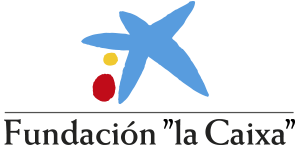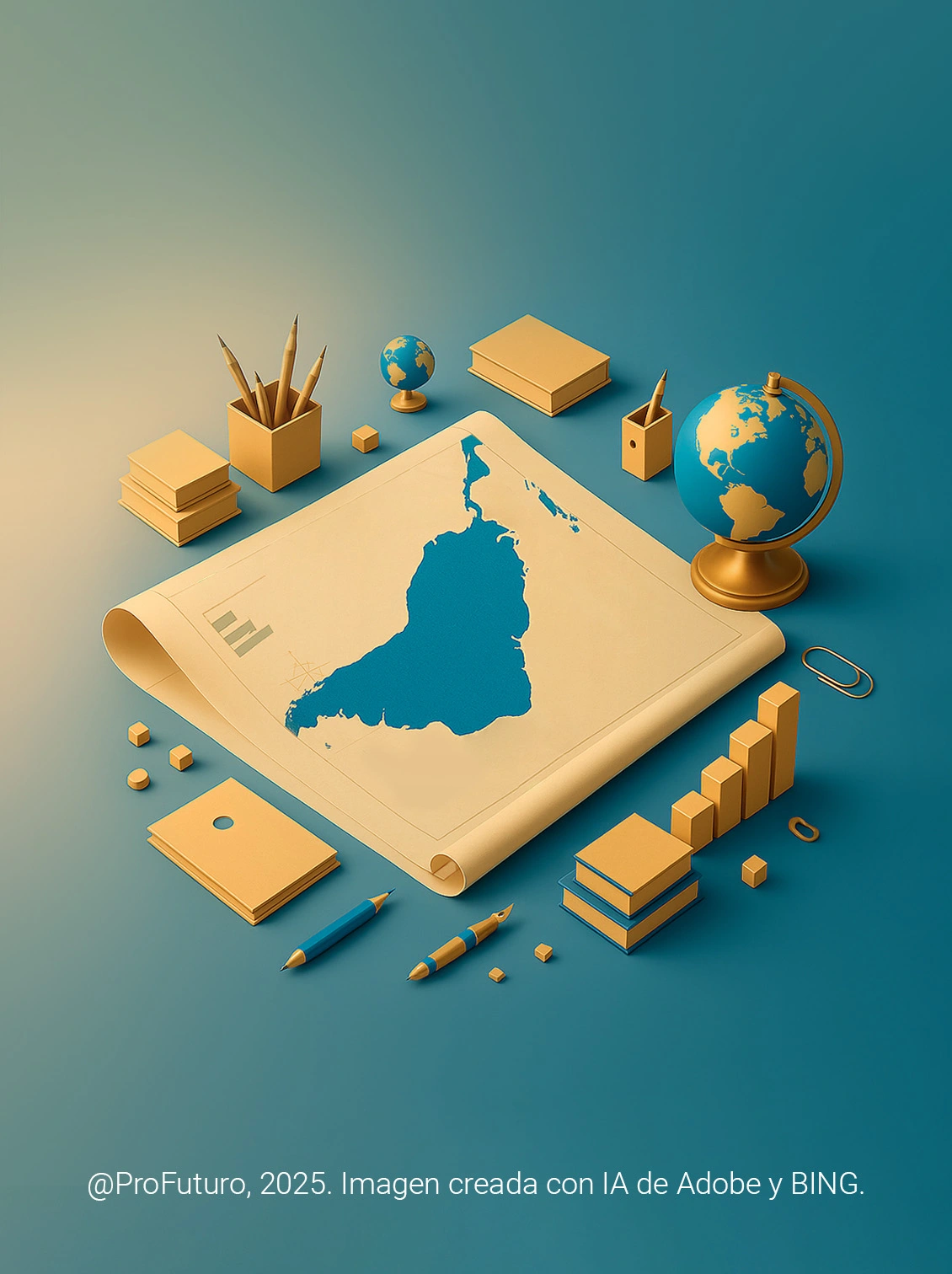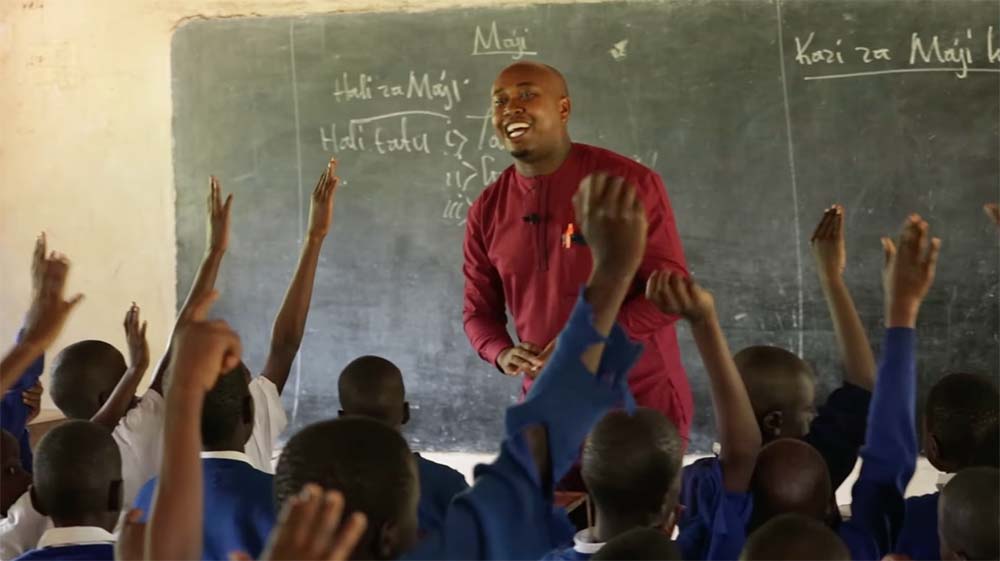
Over recent years, the promise of transforming education through technology has sparked both enthusiasm and scepticism. Some highlight its potential to enable teachers to innovate in their pedagogical practices, while others warn that there is no robust evidence supporting the idea that technology brings about concrete improvements in learning, particularly in vulnerable contexts. In Latin America—a region marked by deep inequalities in access to and quality of education—this debate is more relevant than ever.
Within this context, the ProFuturo Programme, driven by Fundación Telefónica and Fundación La Caixa, has spent nearly nine years working to achieve this ambitious goal: to bring pedagogical innovation based on digital technology to educational communities in vulnerable environments. Since its inception in 2016, the programme has operated in the region under two intervention models: a Comprehensive Model, which works directly with schools; and an Open Model, focused on the professional development of teachers through online training courses.
The question arises immediately: what has been the real impact of this effort on improving student learning and on the situation of the schools participating in the programme? To answer this, the SUMMA Foundation led an exhaustive study in 2024 that aimed to measure—using rigorous tools—the effects of the programme across various countries in the region. The report (soon to be published) provides evidence of the progress achieved, while offering valuable insights into how to scale, adapt, and strengthen this type of initiative.
What Do the Two Intervention Models Offer?
The study developed by SUMMA aimed to identify rigorous and reliable evidence on the effects of ProFuturo in educational contexts across Latin America.
Before discussing the methods used, it is essential to understand exactly what the Comprehensive and Open Models are— the two approaches the programme uses in the field, and around which this study has been structured.
The Comprehensive Model is implemented directly in schools. It involves providing technological equipment (such as tablets and projectors), connectivity, digital resources, and, most importantly, training for teachers in the pedagogical use of these tools. Its approach is systemic: it seeks to transform the teaching and learning experience in each school, supporting both teachers and leadership teams. It is designed to generate structural and sustainable change.
The Open Model, in contrast, focuses on large-scale digital training. It is aimed at teachers who voluntarily access a range of virtual courses on digital competencies and innovative pedagogical practices. It does not require direct intervention in schools or the provision of equipment, which enhances its scalability and enables it to quickly reach a wide range of teaching communities, even in remote areas or outside the formal education system.
A Methodological Note
To evaluate the effects of the ProFuturo Programme, national administrative databases, results from standardised assessments, internal programme information, and—in the case of the Open Model—self-evaluations completed by teachers were analysed.
Additionally, a combination of quasi-experimental methodologies was applied to compare schools and teachers that participated in ProFuturo with those that did not. Techniques such as Propensity Score Matching were used to ensure group comparability, along with Difference-in-Differences analysis, which helps isolate the programme’s effect over time.
As mentioned, the study was organised into two major sections aimed at identifying the impact of both models:
- The Comprehensive Model, which analysed the results of schools in Chile, Brazil, Peru, and Ecuador, focusing on student learning and other school indicators such as attendance and enrolment.
- The Open Model, implemented in nine countries and oriented towards the digital training of teachers through online courses.
In a region where educational innovations often remain trapped in pilot project logic, ProFuturo represents a bold commitment to pedagogically meaningful scaling.
Comprehensive Model: Signs of Impact and Opportunities for Improvement
The analysis of the Comprehensive Model sought to answer three key questions: Are there signs that this model of intervention improves student learning in the region? What effect does this model have on indicators such as enrolment, approval, and school attendance rates? Which specific ProFuturo factors appear to be most associated with these improvements? The analysis, which included 1,277 educational centres across four countries—Chile (55 schools), Brazil (759), Peru (347), and Ecuador (116)—yields results that, while needing to be interpreted with caution, show positive and consistent trends, particularly in Chile and Brazil. That is, there is promising evidence that the Comprehensive Model is producing positive learning outcomes in the schools where it is implemented.
Chile: Significant Progress in Basic Skills
Between 2018 and 2023, Chilean schools participating in the programme showed significant improvements in national standardised tests in Mathematics and Literacy. The scale of this improvement is close to 0.4 standard deviations in Mathematics and 0.3 in Literacy, equivalent to an increase of nearly 12 points more in the SIMCE (Education Quality Measurement System) test in Mathematics compared to control group schools. However, neither enrolment nor approval rates showed statistically significant changes. This may be due to the limited number of participating schools, which makes it difficult to draw definitive conclusions. An interesting point is that schools that took better care of the technological equipment achieved an additional effect in Mathematics, suggesting that the responsible use of resources goes hand in hand with a stronger educational environment.
Brazil: Cross-cutting Impact in the Classroom
Brazil presents a robust picture. Test results in Mathematics and Literacy among upper primary pupils (aged 11 to 14) improved significantly, reaching 0.4 and 0.6 standard deviations, respectively. The evidence is clear: while control schools slightly declined on some indicators, programme schools achieved advances of over 14 points in Mathematics and 23 in Literacy—a leap indicating significant impact. Approval rates also increased, and in some schools, enrolment rose sharply, sometimes by as many as 140 students during the study period. In most cases, consistent technological integration and a committed teaching team appear to be key factors behind this strong performance.
Peru: Enrolment as a Sign of Engagement
Peru’s experience shows a different nuance. Although national standardised tests in Mathematics and Literacy (in Years 2 and 4 of primary school) indicated slight improvements, these were not statistically significant. The most visible sign of impact appeared in school enrolment: many schools receiving the intervention added between 37 and 55 more students compared to similar schools not participating. The analysis suggests that regular technology use and teacher motivation were decisive factors, helping to connect with students and their families and strengthen ties with the school.
Ecuador: Resilience in Challenging Times
In Ecuador, estimating the effects of any intervention is difficult due to the lack of national census assessments of learning. Nonetheless, analysis of enrolment trends shows that schools participating in the initiative lost fewer students than the national average, with an estimated difference of between 14 and 17 pupils, though not statistically significant. Even so, factors such as leadership support and care of technological resources were associated with a smaller drop in enrolment. This hint of resilience suggests that even in adverse environments, certain practices can help counter dropout rates.
In general, the evidence indicates that factors such as effective and pedagogically focused technology integration in the classroom, care of equipment, commitment of school leadership teams, and notably, teacher motivation, are associated with the positive results achieved by the programme.
Open Model: When Teacher Development Drives Digital Transformation
Unlike the Comprehensive Model, which works directly with schools, ProFuturo’s Open Model focuses on large-scale teacher training. Its premise is simple: improving education starts with strengthening those at the front of the classroom. For this reason, the analysis of the Open Model centred on identifying promising evidence of the programme’s impact on the development of teachers’ digital competencies.
SUMMA’s study analysed data from over 1.1 million teachers who participated in Open Model courses between 2018 and 2024, across nine countries in the region: Argentina, Brazil, Chile, Colombia, Ecuador, Mexico, Peru, Uruguay, and Venezuela. The analysis used data from the Digital Competencies Self-assessment, a self-administered survey allowing each teacher to assess their level of technological proficiency in three areas: Pedagogy, Digital Citizenship, and Professional Development, alongside course completion data.
Two analytical models were used. The first examined teachers with a single self-assessment, to assess the relationship between the number of courses completed (and thus training hours) and reported digital competency levels. The second focused on teachers with two assessments at different times, allowing a comparison between those who completed courses and those who did not. While the lack of pre-intervention data limited the ability to make a robust causal estimate, this approach provided a preliminary indication of the Open Model’s potential impact on digital competency improvement. Let’s look at the results.
More Courses, Greater Digital Competency
The first model revealed a positive and statistically significant correlation between the number of courses/hours of training and the levels of digital competency reported by teachers. Those who spent more time on the ProFuturo platform tended to reach higher Familiarisation or Adaptation levels, and in some cases approached the Integration phase in all three dimensions: Pedagogy, Citizenship, and Professional Development. Age emerged as a negatively correlated variable: teachers with more years in the profession tended to report lower digital proficiency, while male teachers reported slightly higher levels than their female counterparts. Educational attainment also mattered, with those holding advanced university qualifications tending to self-assess at higher competency levels.
Country Differences
The analysis showed that Argentina and Chile had higher initial scores, despite having fewer teachers continuing with sustained course participation. In contrast, Peru and Ecuador showed lower average scores but high retention rates, with a considerable proportion of teachers completing 10 or more courses. These contrasts raise questions about the relationship between continuous training, self-declared competency, and actual transformation of teaching practices. They highlight the need to expand and deepen the study of the Open Model to identify cultural, political, and infrastructure factors that facilitate or limit the practical application of digital skills and pedagogical innovation.
Beyond the Numbers: What Makes the Difference?
One of the most valuable contributions of SUMMA’s study is not only showing what results are observed in schools and teachers participating in ProFuturo, but also explaining why. In other words: which elements of the programme’s implementation seem to account for the positive effects observed?
Across different countries and contexts, a series of critical success factors consistently emerged, helping to explain why some schools or teachers are better able to seize the programme’s opportunities:
Integration of Technology with a Pedagogical Focus
Once again, it is shown that the schools where technology is structurally integrated into the teaching process—not as an add-on, but as part of the instructional design—are those showing the best results.
Care and Maintenance of Equipment
Though it may seem like a logistical detail, it is fundamental. The care taken with ProFuturo-provided equipment is directly linked to better performance, especially in mathematics, where a learning platform has helped teachers manage their classroom practice. In successful cases, devices are available, in working condition, and used regularly. In contrast, when resources are poorly managed or damaged, the programme’s potential is diminished.
School Leadership and Commitment of Management Teams
The schools with the best results are those where school leaders not only support the programme’s implementation but make it an institutional priority. Their involvement creates a culture of commitment that permeates the entire teaching team and tends to embed the programme as a core school policy.
Teacher Motivation
An interesting finding is that the general motivation of the teaching staff (whether participating in the programme or not) also affects a school’s outcomes. In schools where there is a palpable enthusiasm for innovation, the programme’s impacts tend to be greater. This reinforces the importance of building cohesive educational communities where change is a shared endeavour.
Ongoing and Contextualised Teacher Training
Closely related to the above, teacher training emerges as a key pillar in both the Comprehensive and Open Models. It is not just about delivering content but providing training that is aligned with local realities, flexible, relevant, and supportive of a critical appropriation of technology. In this regard, the Open Model demonstrates huge potential: its capacity to expand training on a large scale without losing local relevance. This may be the greatest challenge in scaled teacher training efforts.
What We Know, What We Suspect, and What We Still Need to Know
The study ends with a balanced overview. There are clear signs that ProFuturo is producing positive changes in certain contexts and under certain conditions. But there is also an implicit caution: the impact is neither automatic nor uniform. It depends on how the programme is implemented, who leads it, and how it is embraced by the educational community.
This leaves us with several lessons:
- Technology is not a magical solution, but it can be a powerful lever when embedded in clear pedagogical strategies.
- Teacher training is the silent engine behind any lasting educational transformation.
- School leadership and institutional commitment are what distinguish a programme implemented “as a formality” from one experienced as a genuine opportunity for improvement.
Recommendations for the Future: Towards More Robust and Strategic Evaluation
The study proposes a series of key recommendations to guide the next steps for ProFuturo and, by extension, other similar initiatives in the region:
Design a More Rigorous Impact Evaluation
The current study provides promising but partial evidence. To confirm the findings and better understand the mechanisms of change, we must move towards evaluations with greater statistical power, clear baselines, and longitudinal follow-up.
Deepen Case Studies and Qualitative Analysis
Numbers tell only part of the story. To understand how ProFuturo is implemented in practice, what barriers schools face, and which strategies work best, it is necessary to listen to the voices of teachers, headteachers, and students. A qualitative approach is essential for enriching our understanding of the processes.
Strengthen Theories of Change
The study shows that local variations of the programme exist depending on the country and context. It will be necessary to build a clear, coherent, and shared Theory of Change that serves as a common roadmap for planning, monitoring, and evaluation.
Invest in Educational Data Infrastructure
One of the study’s major challenges was accessing standardised and comparable data across countries. If we wish to move towards evidence-informed policy, national education systems must improve the quality and availability of their data, including indicators on learning, enrolment, retention, and equity.
Promote Improvement Communities and Learning Networks
Finally, the study recommends that ProFuturo continue to commit to a logic of continuous improvement and horizontal collaboration. Initiatives like Networked Improvement Communities (NICs) allow schools to learn from each other, share strategies, and build collective knowledge.
A Commitment to Real and Symbolic Transformation
In a region where educational innovations often remain trapped in pilot project logic, ProFuturo represents a bold commitment to pedagogically meaningful scaling. It is not about handing out tablets or ticking boxes through courses—it is about transforming the educational experiences of teachers and students from the ground up; that is, with technology serving a pedagogical purpose.
This study does not offer definitive answers, but it opens the door to a more honest, evidence-based conversation about what works, what doesn’t, and what can be improved. And that, in itself, is already a fundamental step forward.
Note: This evaluation was carried out by SUMMA’s research team, composed of Dante Castillo-Canales, María José Sepúlveda, Nuvia Rosas Zambrano, Nicolás Caglevic, and Lucas González Biedma. We deeply appreciate their rigorous and dedicated work throughout the entire process.






